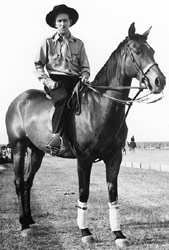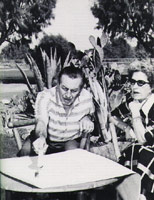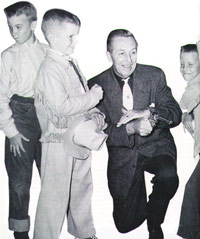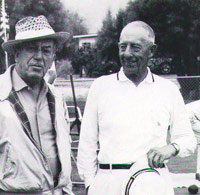By Allene Arthur
Photography by Paul Pospesil courtesy of the Palm Springs Historical Society
What did Walter E. Disney do for fun in the desert? He loved to ride horseback. He was crazy for lawn bowling. And more than a few neighbors recall Walt's attempts to get them to invest in some cockamamie amusement park.
How did the man who practically invented good times, entertainment and dazzling fantasy for generations of the masses get his own kicks? What did Walt Disney, grand master of the animated film, Lord of theme parks, and daddy of Mickey Mouse do for his own fun and games?
Walter Elias Disney would come to Palm Springs.
The earliest remembered appearance of him in the desert that was to become his personal retreat was in 1936, when the blossoming genius played polo on the grounds where Palm Springs Stadium now stands. Disney was 35 that year. Mickey Mouse, the world's most beloved rodent, was eight.
 It was Disney the horseman who initially gravitated to the Coachella Valley. Frank Bogert, Palm Springs' former cowboy mayor and leather-bound human encyclopedia of desert history, recalls that particular Walt Disney. Both were young buckaroos, tall in the saddle, who rode with the Rancheros, a riding group embarking on an annual mounted journey.
It was Disney the horseman who initially gravitated to the Coachella Valley. Frank Bogert, Palm Springs' former cowboy mayor and leather-bound human encyclopedia of desert history, recalls that particular Walt Disney. Both were young buckaroos, tall in the saddle, who rode with the Rancheros, a riding group embarking on an annual mounted journey.
For three years Bogert and Disney were in the same camp during the horseback odyssey. "When you camp with a guy, you really get to know him," says Bogert. "He was the best."
Along about this time, the Disney organization was producing its first feature-length animated film, making motion picture history. Soon Sleepy, Doc and Dopey were better known to most Americans than the names of Congressmen. Along with Sneezy, Grumpy, Bashful and Happy, each cartoon character in Snow White and the Seven Dwarfs displayed such differentiated personalities in the groundbreaking movie that Disney, with pen and ink, made them seem more real that Gable or Garbo. It was a technique that would later bring Dumbo to endearing life, as well as Bambi, Cinderella, Jiminy Cricket, Tinkerbell and decades of lovable, heart-melting additions to Americana.
During the years the Walt Disney Company was turning out such meticulously crafted illusion, riding buddies Frank and Walt kept in touch.
 Disney and his wife Lily bought their first Palm Springs home in 1948 at Smoke Tree Ranch, the upscale rustic development of homes faithful to desert authenticity where mesquite and ocotillo grow in undisturbed harmony, and small animals scurry among the rocks and cactus.
Disney and his wife Lily bought their first Palm Springs home in 1948 at Smoke Tree Ranch, the upscale rustic development of homes faithful to desert authenticity where mesquite and ocotillo grow in undisturbed harmony, and small animals scurry among the rocks and cactus.
Jacques and Marjorie Crommelin were Smoke Tree neighbors. "At first we feared Disney would change the desert planting and make his place look like Beverly Hills," says Marjorie, "but he fit in very, very well with both our residents and our way of life."
He was unassuming and friendly, she said, wore his casual riding clothes and didn't get any special attention. Perhaps that's what moguls want when they intermittently leave the Hollywood glitter and strain – for a mogul Disney had indeed become. Now the pictures of the undisputed king of family entertainment, who started by penning animated commercials for an ad firm in Kansas City, were collecting shelves of Academy Awards.
Meanwhile, back at the Ranch, Lily kept their attractive desert home warm, hospitable and southwestern. Their two daughters played with the two daughters of Marjorie and the late Loring Merwin. "Disney was concerned about Smoke Tree," Marjorie says. "He was influential in getting our bowling green started." Thereafter, Disney was a fervent lawn bowler, even entering the tournaments. He cherished the occasional cup he won with as much pride as his army of Oscars.
 But the mind of the visionary was continually whirring. Disney had a dream in his imagination, combined with a concept in his practical brain, of a fantasy super amusement park.
But the mind of the visionary was continually whirring. Disney had a dream in his imagination, combined with a concept in his practical brain, of a fantasy super amusement park.
He confided his fanciful scheme to Bogert, as well as his steep efforts to raise the funds to construct what would amount to a complete new city.
"He hocked everything he had, including his house," says Bogert. "He borrowed from everyone he knew." In 1954 he sold his first Smoke Tree Ranch home.
Charles Shows, now retired to Palm Springs, worked as writer, director and producer for Disney studios for several years. He remembers his boss's struggle for $17 million to build his own Oz on 160 acres in Anaheim. "Predicting Disneyland would be a colossal flop was my second biggest mistake," laments Shows. "My first biggest mistake was not buying Disneyland stock."
Eventually, Disney persuaded the American Broadcasting Company, Santa Fe Railroad, Bank of America and several other corporate giants, to kick in capital for what was to become the entertainment success story of its age.
Whenever a group of Bogert's charro friends from Mexico came to town, their unvarying wish was to see the magic of Disneyland. "Every time I called," remembers Bogert, "Walt broke his neck for me and them. We were shown the back end of manufacturing what the public saw."
 Soon the Mickey Mouse Club had seized the television-viewing children of America. Disney had half the kids in the country wearing Mickey Mouse ears – that is when they weren't wearing Davy Crockett's coonskin caps, another fashion accessory inspired by a Disney TV series. "Walt was a merchandising and marketing wizard," says Shows simply.
Soon the Mickey Mouse Club had seized the television-viewing children of America. Disney had half the kids in the country wearing Mickey Mouse ears – that is when they weren't wearing Davy Crockett's coonskin caps, another fashion accessory inspired by a Disney TV series. "Walt was a merchandising and marketing wizard," says Shows simply.
Few people in the desert recognized the man whose name they all knew. "There was no hullabaloo over him around Palm Springs," recalls Marjorie Crommelin. She said it was only when his face became familiar as television host of the weekly Disney anthology series that he was recognized.
Not that he combed the town. Though he often came into Sorrentino's restaurant in North Hollywood, the late owner Mary Sorrentino could not recall one Disney visit to the Palm Springs Sorrentino's.
You would more likely encounter Disney on a mountainside horse trail than partying at the Racquet Club. The relaxed, more countrified outdoor living of Smoke Tree Ranch seemed to have the getaway appeal the multi-enterprise tycoon wanted and needed.
Disney was not, however, the condescending celebrity who used Smoke Tree only for his own recreational escape. He was an involved participant in its function as a village within a village.
To cite one example, the chief put the talent of his vast studios at Smoke Tree's disposal. Brad Poncher, Smoke Tree's present-day vice president and general manager, recalls that Disney studio set designers were responsible for the design of some of the ranch's guest cottages. The designers' resumes could theoretically include the sweeping design of blockbuster motion pictures, plus that of some remote cabins in the desert.
To this day, brochures about these facilities available to ranch vacationers list them as "Disney Cottages" and "Deluxe Disney Cottages." (Pluto and Goofy are not dancing at the entrance of the Deluxe. It's simply larger.)
 The studio expertise didn't always work, but the effort was no less conscientious. Marjorie Merwin remembers that when the road fronting Smoke Tree was paved, two things happened. The ranch moved the stables back to a location away from the highway, and taxes rose.
The studio expertise didn't always work, but the effort was no less conscientious. Marjorie Merwin remembers that when the road fronting Smoke Tree was paved, two things happened. The ranch moved the stables back to a location away from the highway, and taxes rose.
Smoke Tree's board of directors was confronted with a decision of how to generate revenue from the new frontage. Disney loaned the services of his studio professionals to the board. Their recommendation was to use the land for pony rides and a bowling alley. (The suggestion was less than agreeable to the directors, which is why you see Smoke Tree Shopping Center anchored by Ralphs supermarket there today.)
Merwin discloses the anecdote only to illustrate Disney's sense of allegiance. "He was a participating resident," he says, "and a good citizen."
Though Disney was what is now described as "laid back" around his Palm Springs Shangri-la, he put his general's stars back on when he returned to the big city. You don't command a triumphant army while lolling around a bowling green in your Levi's.
Charles Shows observed the professional Disney for more than a decade as an employee shaping scripts, directing action and sweating over production for Walt. The boss insisted that everyone from floor sweepers to upper executives call him Walt.
From his Palm Springs home, Shows describes Disney as "a fine man, an honest man, a decent man and an old-fashioned patriot."
He was also, says Shows, "an authoritarian – tough and strict like a stern father, like one who gets you mad when he smacks you on the butt, but stopped you from being a crook."
Disney inspired loyalty among the then more than 2,000 employees. "Loyalty was spread over the place like molasses," says Shows.
One sidelight to the Disney persona Shows saw was the incongruous habit of the famous creator of sweet, adorable creatures, to swear. "I think it was his idea of being a man among men, a mark of manhood. He cussed when he didn't need to. He wanted to be a cowboy, but had no cows," Charles reflects. "So he put on his Sears Roebuck boots and swore." Among the guys, he favored the S.O.B. reference and the S-word. With women, he was as gentlemanly as his own big screen Prince Charmings.
Disney was also part child, else how could he have known how to grab the imagination of children – as well as the children still lurking inside grown-ups – so thoroughly.
Denis Neumayer, now a car salesman at Mac Magruder's Chevrolet in Palm Springs, remembers at age 13 accompanying his doctor uncle who took care of one of Disney's Los Angeles neighbors. The lad was always warmly invited by the magnate himself to ride the small-scale train that circled his backyard. "He was nice to kids," states Neumayer. "A serene gentleman. I called him Uncle Walt."
The Disneys purchased their second Smoke Tree Ranch home in 1957. Disneyland, now open two years, had exceeded Uncle Walt's entrepreneurial hopes. Old Yeller was a big live-action hit, and the animated Sleeping Beauty was on the drawing board. Disney was 56. Mickey Mouse was 29.
On the bulletin board at the Disney Studios, Shows recollects, was a sign-up sheet for anyone who wanted to use the Smoke Tree home when Disney's family wasn't. "Walt was democratic as hell," Shows chuckles, "even though he was Republican in thought and deed."
Shows says that the boss never paid employees very much, explaining to them they were all there to make pictures, not money. "If he made a million from one picture," says Shows, "he didn't retire to Miami. He'd take that million, borrow another million and make another picture."
Disney left vexatious money matters to his brother Roy. Shows quotes Walt as saying, "I make up the impossible dream, and it's Roy's job to pay for the damned thing."
Though salaries were low, regard for studio writers was high. "Disney was smart," Shows declares. "He knew the story was the guts of any production. He worshiped talent, because he was a lousy artist and he couldn't write." He made up for skinny paychecks (emblazoned with logos of Mickey Mouse), Shows reports, with luxury working conditions. He gave writers freedom, time and a trustful atmosphere in which to conceive and create.
In the early 1960s Don Cravens, now of Rancho Mirage, was an ace photographer for Life magazine, recording the major stories of the moment. Sometimes he got assignments from Time, the magazine's sister publication, and he vividly recalls the one when Disneyland was expanding, adding even more to its original wonderland. The shoot was at a Burbank warehouse. The subject was Disney and the scale model of the Disneyland expansion.
The words which first come to Cravens' mind in describing Disney that day, proudly showing the mock-up of his growing baby, are "enthusiastic, excited and courteous." He adds, "The man had a wonderful reputation."
In 1965, desert residents Sirphue and John Conte were planning to develop the valley's first local TV station. Their former Los Angeles neighbor Walt Disney wanted to be involved as a partner.
"He was a wonderful man, a gentle man," says Sirp. "He was happy in the desert. He was particularly glad that he could fly here in only 20 minutes."
That year Disney told the Contes he had just purchased 25,000 acres in Florida for the next Disneyland. But he was neither to become a partner in what became KMIR-TV, nor to see the opening of what became Disney World. He died in 1966 of acute circulatory collapse following surgery for removal of a lung tumor. He was 65. Mickey was 38.
Walt Disney Hall at Smoke Tree Ranch stands peacefully by the pool, facing the mountains, not far from the emerald bowling green. Brad Poncher says the hall, named for one of the country's most eminent innovators, is used for banquets, lectures and social gatherings. Photos of Disney at ease in Palm Springs decorate the walls.
"I often wonder," says Frank Bogert, "what Walt would think if he could see how gigantic the Disney empire has become."
One wonders if the cartoonist from Kansas City could have predicted that his namesake company would one day, besides its films and theme parks, own baseball and hockey franchises, hotels, a cruise line, publishing and software businesses and a major TV network – for a total company market value of $53 billion.
You also have to wonder what Uncle Walt, who put the emphasis on quality production rather than on plump paychecks, would think about Disney chairman and C.E.O. Michael Eisner's base salary of $750,000 and stock options now estimated at $230 million. What would the man who mortgaged his eyeteeth think about former second-in-command Michael Ovitz being given a few mil just to take a walk?
Mickey Mouse is 70 this year, and spry as ever. That's a pretty good legacy from a desert rat named Walt Disney.
This story first appeared in the pages of Palm Springs Life in December of 1997.